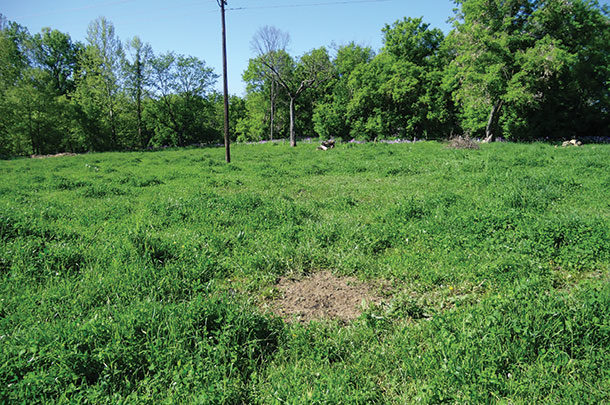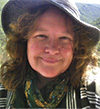Did you turn out in late March when the average temperatures across the northern part of the U.S. were well above the norm?
Given the unprecedented weather patterns on record (again), it’s worthwhile to take a step back and re-evaluate the “norm” for pasture turnout. Let’s review some of the known issues and the uncertainties.
Frost and storm damage issues
If you are still in a situation where frost is probable, take into consideration the stage of development of accessible deciduous vegetation in grazing environments. Why? Because a spring frost on budding leaves of certain tree species can result in accumulations of lethal toxins. Certain grasses can also release lethal toxins after a frost.
Livestock seek out the high nitrogen content of budding tree leaves for protein and as a source of minerals. Who hasn’t seen a group of cows stretching up to snatch a branch of succulent spring foliage? However, if frost occurs, those tender shoots can become deadly. Wilted leaves of chokecherry, box elder, oaks, red maples and sycamore maples are all capable of killing livestock and horses.
All members of the Prunus genus (cherries, pears, peaches, apricots, plums) can produce cyanide glycoside in frosted leaves and seeds. Box elder and sycamore maple seeds can produce hypoglycin-A. Oak buds, leaves and acorns produce toxic tannins, and a toxin in red maple leaves can produce lethal amounts of gallic acid.

It is important to know how different species of livestock react to these toxins if ingested. Ruminants tend to consume more than monogastric animals, thus increasing the likelihood of death by poisoning. On the other hand, horses are highly susceptible to toxins that may not affect cattle or sheep.
Poisoning from ingestion of red maple leaves in horses is called “seasonal myopathy.” While cyanide poisoning in cattle is usually immediate, death from oak tannins can take three to four days.
If an animal is still alive, it’s not too late to call the veterinarian and administer activated charcoal and mineral oil. But be sure to tell the veterinarian if you suspect Prunus poisoning, oak poisoning, etc. Some toxins can be counteracted with injections of vitamin C, sodium nitrite, sodium thiosulfate or rumen evacuation.
Sadly, though, more often than not, the animal is already dead or dying upon discovery. It can take as little as a pound of wilting leaves containing hydrogen cyanide to kill a 900-pound heifer.
What can you do?
Walk your fence
If you are unsure which tree species are toxic, cut back any overhanging branches. Usually cattle have already browsed off accessible branches inside fence boundaries. But be on the lookout for recently downed branches. A flush of tree seedlings, especially seedlings in flooded areas, should also be suspect; who knows what might have germinated?
In this instance, clipping the pasture and waiting several days for the toxin to leach out of the clippings is a reasonable precaution. Keep in mind, though, that if conditions are right, any amendment to the growth stage of the forage crop (frost-induced, clipping, fertilization) can result in grass tetany or nitrate poisoning.
Naturally occurring grasses like arrowgrass can also cause nitrate or prussic acid poisoning after a spring frost. According to the FDA Poisonous Plant Database, the spring emerging semi-aquatic arrowgrass species is most poisonous during dry periods when growth is stunted.
Monitor the forecast
If frost is forecast, restrict livestock access from lush growing pastures or areas that contain a lot of oaks, cherries, etc. If a spring storm hits and lightning is reported, get down to the fields before cattle begin browsing. I personally lost a second-calf Angus cow due to a lightning strike after a wicked May storm in 2014.
I learned upon investigation that the wet sandy Pope soil was a great conductor of lightning. The bolts had splintered a tree across the river and one in the pasture. The cow was found dead standing over the top of a buried phone cable and beneath a high-voltage power line.
I learned a few things from that assessment.
- The energy of a lightning strike can travel underneath the ground for some distance before coming back to the surface.
- Every farmer has a buried metal line or a high-voltage power line running through at least one pasture.
- Take time-sequence photos of the area where the animal died and of the dead animal. I noticed discolored grass tips next to an odd-looking bare spot near where the cow dropped.
Over the course of three days, a long streak of dying grass emerged next to this bare spot. It was fairly obvious that I was seeing a scorch mark from the bolt of lightning’s energy.
- Make sure you’re up-to-date on your cattle insurance and have adequate coverage for “acts of God.”
Other uncertainties
The transition of cattle on feed to succulent grass comes with its own pitfalls. Producers worried about grass tetany can make adjustments in mineral mixes to account for an unequal magnesium-potassium ratio in fast-growing grasses. Forcing livestock to eat dry hay before turnout is another preventative measure. However, neither option is foolproof, as cattle like to eat, a lot.
The best advice? Know your soil fertility levels. Especially if you altered the natural fertility status of the pasture with applied fertilizers and lime. High-cal or high-Mg lime can quickly, at least initially, alter the ratio of three cations in the soil.
This can lead to luxury consumption of calcium (C), potassium (K) and magnesium (Mg) during periods of rapid plant growth. For more reading on this topic, see the fact sheet “Where Do Cations Fit in My Fertility Program,” available from the Potash and Phosphate Institute.
Soil type and rainfall can also affect the ratio of these cations in the soil. Sandy soils might call for potassium in a fertilizer analysis, but if it doesn’t rain, the cation will not have leached away, creating a potential imbalance of K to Mg. This unequal absorption can lead to grass tetany. Milk fever (hypocalcemia) is another one to watch out for, especially if soon-to-freshen cattle are turned out in clover-rich pastures.
Nitrates
The above-mentioned fertilization program can also lead to nitrate toxicity in the spring. Be extra diligent in recording where, when and how much urea and ammonium sulfate fertilizer were applied prior to grazing. For instance, you top-dressed a winter small-grain cover crop in hopes of getting harvestable forage, but the weather turned (too wet, too dry) and not enough growth occurred to make it worth your while.
You decide, though, to graze it off – but realize too late that the succulent tips of the small grain are high in nitrogen, which becomes:
Nitrate (NO3) ——› Nitrite (NO2) ——› Ammonia (NH3) ——› Amino Acid ——› Protein
When the nitrate is too high, too much nitrite accumulates in the rumen – and cows start dying. Nitrate toxicity can also occur naturally in rapidly growing grasses after a spring frost.
Sweet clover poisoning
Speaking of clovers, be aware that yellow (Melilotus officinalis) or white (Melilotus albus) sweet clover can have lethal levels of coumarin. In the Northeast, sweet clover is frequently found growing alongside pasture fences and roadside ditches. It’s quite possible seed migration could occur into a pasture after flooding.
Flooding
Throw out the book if your pastures were flooded. Who knows what man-made toxins, poisonous plant parts or deadly bacterium got left behind in the sediment and debris of a catastrophic flood incident? Keep livestock from these pastures until they can be inspected and, if possible, remediate.
Be on the lookout for lead-containing batteries, another dead-as-a-doornail culprit.
Knock on wood, here’s hoping you have a safe and uneventful turnout to the start of 2016. ![]()
Melissa Bravo is a certified crop adviser and herd health specialist with Meadow Lake Farm Consulting. Email Melissa Bravo.
PHOTO 1: This photo shows where the cow died when a tree in the pasture and one across the river were hit by lightning. The cow was found dead over the top of a buried phone cable and beneath a high-voltage power line. The photo was taken the day the cow died.
PHOTO 2: This photo shows the same location, taken on day-3, where the wet sandy Pope soil, which is a great electrical conductor, had started to regenerate vegetation. Photos by Melissa Bravo.









